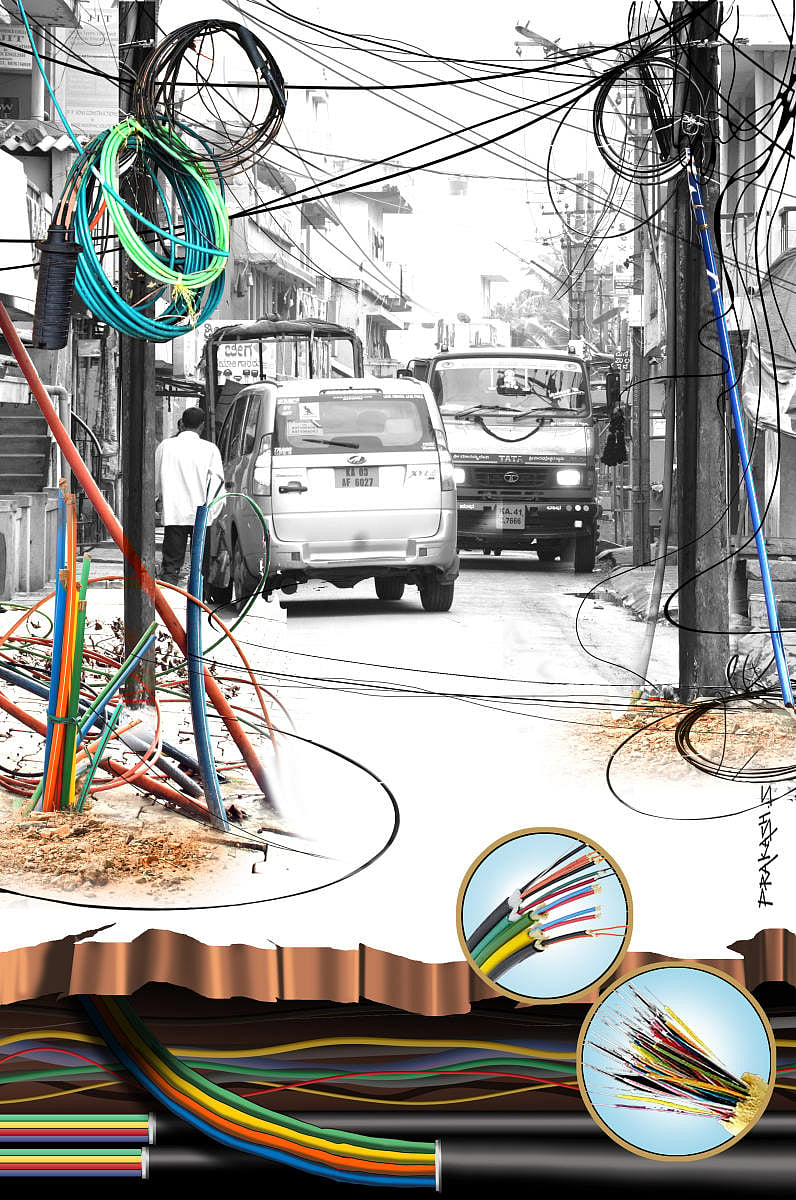This should clearly be a no-brainer: Dedicated underground utility lines crisscrossing the city to rid Bengaluru of all its ugly overhead Optic Fibre Cables (OFCs) and power lines. But for the Bruhath Bengaluru Mahangara Palike (BBMP), battling to contain the OFC menace, this sounds like rocket science!
Faced with multiple telecom firms digging up roads to lay and relay these cables without permission, the Palike tried taking the easy route: It imposed a total clampdown on all digging. Even approvals granted before were withdrawn. The move was bound to fail, and it did in no time.
READ: Ban or no ban, telecom firms must restore dug-up roads
Short-lived ban
Massive internet outage had citizens of the tech city in turmoil. Broadband connectivity, unpredictable even without a ban, slipped out of control. Telecom firms, penalized for digging up roads without the Palike green signal, banked on the mounting public complaints. Just days after its ban, BBMP was forced to revoke it.
So, is it back to Square One? Not exactly, the Palike has banned all overhead OFC cables with a firm condition even on underground laying: Permissions for cables will be restricted to two kilometers in one go, with a time limit of 60 days on each approval. If the applicant fails to lay the cables within this timeframe, the permission will be considered void.
But the shift to the underground will be with retrospective effect. To get this going, OFC and telecom operators will be served notices to take down all existing cables within the next few days. Will this trigger a massive road-cutting exercise by multiple telecom firms?
Poor coordination
For citizens, long at the mercy of multiple civic agencies working at cross purposes, dug-up roads have always been an unending nightmare. Besides the Palike, the Bangalore Water Supply and Sewerage Board (BWSSB), the Bangalore Electricity Supply Company Limited (Bescom) and the Bangalore Metro Rail Corporation Limited (BMRCL) have all been guilty of poor inter-agency coordination.
Telecom lines have only added to the chaotic mess underground. Dug-up roads are often left without restoration by all the parties concerned, further shrinking the already overstretched road space. Well aware of this, the Palike has decided to restore roads on its own, but with a charge: Rs 50 per metre.
Yet, this does not answer a fundamental road design question: Why are city roads not laid with permanent underground utility lines? The TenderSURE roads with UG ducts underneath the footpath does offer a model to scale up, although telecom firms have been caught bypassing even them to escape the costs involved.
Road design gaps
Indeed, TenderSURE roads with a pedestrian-first approach are expensive to build. But what prevents the Palike from adopting its design that essentially negates the need for frequent road-digging? Yes, digging contracts will dry up, since the design incorporates prefabricated openings at regular intervals to aid maintenance and repair.
For telecom firms, the new BBMP rules spell more time and effort to get approvals: Areas where OFCs are to be laid, and the number of chambers required, will have to be specified. Chambers are critical for cable-route branching and maintenance.
But undergrounding without a holistic approach could go seriously wrong, warn urban design experts. Multiple agencies digging up the road without common ducts would be a disaster. “Bescom, for instance, is also shifting its overhead lines underground. There needs to be a proper plan,” notes urban architect Naresh Narasimhan.
Retrofitting
Can retrofitting the city roads with permanent utility ducts underneath the footpaths be an option? “Yes. We did it on Church Street where the underground was in a complete mess. The costs will work out,” he notes.
Spending Rs 50 lakh to Rs 1 crore on a road every year, Narasimhan explains, is far costlier than spending Rs 5 crore one-time. “ Look at the TenderSURE roads, are there any potholes there?”
But permanent ducts would mean a permanent solution, which the contractor-corporator-bureaucrat mafia is not keen on. So, the cable operators and OFC firms were given blanket permission for a year or more. They could dig whenever, wherever. Only when the chaos hit the roof has the Palike woken up, notes an insider.
Stringent conditions
The Palike’s Chief Engineer, OFC Cell, M V Prasad says fresh permissions to lay cables would now be given with stringent conditions. “There are about 1,200 kms of overhead cables. These have to be shifted underground. We are trying to do our best,” he says.
Footpaths are often the first target of agencies that are forced to take the cables underground. This would invariably be at the cost of walkability and cycling spaces, notes Sathya Sankaran from the Citizens for Sustainability (CiFoS).
Walkability issues
In many cities abroad, the footpath area identified for trench work is barricaded and safe walking paths created. “Here, they don’t care where the pedestrians go. They should realise that footpaths are multi-functional, where public toilets, vendors, street furniture and more make it more complex than the road. In fact, they should allot more budget for footpaths and restoration than roads,” Sankaran explains.
Will the threat of hefty penalty and even criminal action, initiated at least on two occasions, against telecom majors arrest the haphazard road-cutting problem?
While one company had to shell out Rs. 68.14 lakh, another had to respond to a police complaint registered under the Karnataka Prevention of Damage to Public Property Act, 1984.
The consensus is this: It could work provided the big nexus, well-entrenched and well-oiled so far, is broken and a semblance of concern for the road-users is established.
